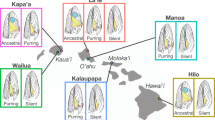Abstract
IN many animals that use rhythmic acoustic or bioluminescent sexual communication, neighbouring males precisely synchronize their signals1–4. This event has previously been interpreted as a development whereby cooperative individuals benefit from maintenance of species-specific signalling rates5,6, minimization of predation risks7,8, or maximization of peak signal amplitude of a local population2,9. Our recent findings on chorusing in the neotropical katydid Neoconocephalus spiza (Orthoptera: Tettigoniidae), however, refute for this species all three hypotheses that claim that synchrony is adaptive. Instead, we demonstrate that synchrony can be an epiphenomenon created by competitive interactions between males jamming each other's signals. The mechanism generating this interference is shown to be an evolutionarily stable strategy (ESS) maintained under sexual selection for exploiting a critical psychoacoustic feature: females orienting toward signalling males choose the leading call in a closely synchronized sequence.
This is a preview of subscription content, access via your institution
Access options
Subscribe to this journal
Receive 51 print issues and online access
$199.00 per year
only $3.90 per issue
Buy this article
- Purchase on Springer Link
- Instant access to full article PDF
Prices may be subject to local taxes which are calculated during checkout
Similar content being viewed by others
References
Alexander, R. D. in Insects, Science, and Society (ed. Pimentel, D.) 35–77 (Academic, New York, 1975).
Wells, K. D. Anim. Behav. 25, 666–693 (1977).
Carlson, A. D. & Copeland, J. Q. Rev. Biol. 60, 415–436 (1985).
Morin, J. G. Fla. Ent. 69, 105–121 (1986).
Walker, T. J. Science 166, 891–894 (1969).
Lloyd, J. E. Nature 245, 268–270 (1973).
Otte, D. in How Animals Communicate (ed. Sebeok, T. A.) 334–361 (Indiana Univ. Press, 1977).
Tuttle, M. D. & Ryan, M. J. Behavl ecol. Sociobiol. 11, 125–131 (1982).
Buck, J. & Buck, E. Am. Nat. 112, 471–492 (1978).
Walker, T. J. & Greenfield, M. D. Trans. Am. ent. Soc. 109, 357–389 (1983).
Greenfield, M. D. Anim. Behav. 36, 684–695 (1988).
Greenfield, M. D. in Biology of the Tettigoniidae (eds Bailey, W. J. & Rentz, D. C.) 71–97 (Springer, Berlin, 1990).
Buck, J. et al. J. comp. Physiol. A144, 277–286 (1981).
Hanson, F. E., Case, J. F., Buck, E. & Buck, J. Science 174, 161–164 (1971).
Buck, J., Buck, E., Case, J. F. & Hanson, F. E. J. comp. Physiol. A144, 287–298 (1981).
Sismondo, E. Science 249, 55–58 (1990).
Maynard Smith, J. & Price, G. R. Nature 246, 15–18 (1973).
Partridge, B. L. & Krebs, J. R. Anim. Behav. 26, 959–960 (1978).
Maynard Smith, J. Evolution and the Theory of Games (Cambridge Univ. Press, 1982).
Burk, T. E. Fla. Ent. 65, 90–104 (1982).
Belwood, J. J. & Morris, G. K. Science 238, 64–67 (1987).
Lakes-Harlan, R. & Heller, K.-G. Naturwissenschaften 79, 224–226 (1992).
Robert, D., Amoroso, J. & Hoy, R. R. Science 258, 1135–1137 (1992).
Kirkpatrick, M. & Ryan, M. J. Nature 350, 33–38 (1991).
Otte, D. & Loftus-Hills, J. Ent. News 90, 159–165 (1979).
Greenfield, M. D. & Shaw, K. C. in Orthopteran Mating Systems: Sexual Competition in a Diverse Group of Insects (eds Gwynne, D. T. & Morris, G. K.) 1–27 (Westview, Boulder, 1983).
Bailey, W. J. Acoustic Behaviour of Arthropods (Chapman & Hall, London, 1990).
Author information
Authors and Affiliations
Rights and permissions
About this article
Cite this article
Greenfield, M., Roizen, I. Katydid synchronous chorusing is an evolutionarily stable outcome of female choice. Nature 364, 618–620 (1993). https://doi.org/10.1038/364618a0
Received:
Accepted:
Issue Date:
DOI: https://doi.org/10.1038/364618a0
This article is cited by
-
Gone with the wind: Is signal timing in a neotropical katydid an adaptive response to variation in wind-induced vibratory noise?
Behavioral Ecology and Sociobiology (2020)
-
Does leadership indicate male quality in Neoconocephalus katydids?
Behavioral Ecology and Sociobiology (2017)
-
Phylogeographic structure without pre-mating barriers: Do habitat fragmentation and low mobility preserve song and chorus diversity in a European bushcricket?
Evolutionary Ecology (2017)
-
Animal choruses emerge from receiver psychology
Scientific Reports (2016)
-
Effects of acoustic environment on male calling activity and timing in Neotropical forest katydids
Behavioral Ecology and Sociobiology (2016)
Comments
By submitting a comment you agree to abide by our Terms and Community Guidelines. If you find something abusive or that does not comply with our terms or guidelines please flag it as inappropriate.



